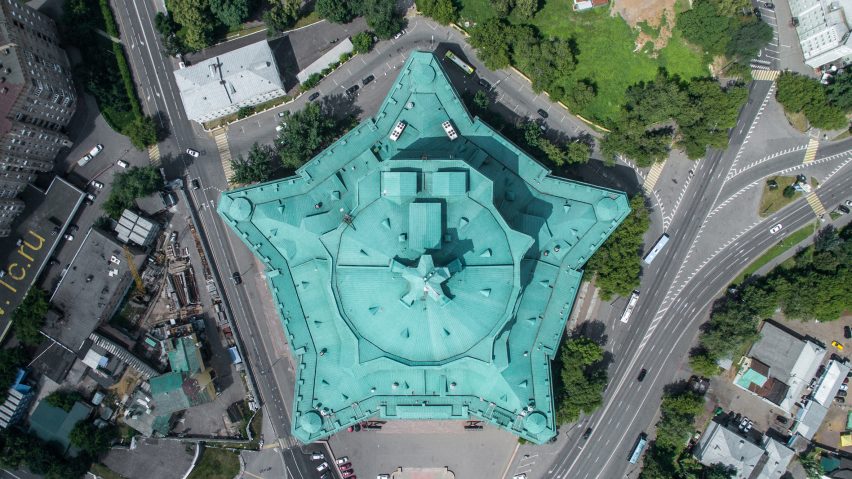Photographer Denis Esakov has used a drone-mounted camera to trace the history of Moscow's architecture, featuring buildings from the city's constructivist era alongside contemporary designs by architects including Zaha Hadid and David Adjaye.
Local architectural photographer Esakov spent one year taking the bird's eye perspective images, using a Zenmuse X3 drone camera flown by colleague Alexander Kavderko.
The images, which are published in the book Spying on Moscow: A Winged Guide to Architecture, chart 100 years of construction in the Russian capital through 70 buildings. Esakov told Dezeen that he chose buildings that were both important to Moscow's history as well as impressive when seen from above.
"I had three criteria: architectural significance, plan view and availability for shooting," he told Dezeen. "The first list consisted of architectural 'stars', from which I then removed those whose plan looks very simple."
Among key projects captured from above is the self-designed home of architect Konstantin Melnikov, Melnikov House. Completed in 1929, it features a pair of cylindrical volumes, with the larger punctured by hexagonal-shaped windows.
Melnikov House is an example of the city's constructivist architecture, and has the stripped-back style that grew in the country during the 1920s and 30s in the aftermath of the 1917 Russian Revolution.
Esakov's series documents the work of another well-known architect of the style, Vladimir Shukhov. His Shukhov Radiotower, which was built in 1922, features a gridded steel shell that forms a conical structure rising 160 metres high.
The drone imagery also reveals the star-shape and green roof of Moscow's largest theatre, The Central Academic Theatre of the Russian Army.
Built in 1929, the theatre forms one of the first examples of Stalinist architecture – the style that was developed in the Soviet Union under Joseph Stalin. Esakov also documents the 1931 Government Building, which was designed by Boris Iofan and adheres to the Stalinist style.
Contemporary designs featured include Zaha Hadid Architects' Dominion Office Building – a seven-storey office block with cantilevered floors that was completed in 2015.
The Skolkovo School of Management, Moscow's graduate business school, which was completed by British firm David Adjaye Associates in 2009 is in the series. It is made up of four volumes of different sizes set on a circular base.
Esakov also took ground shots with a Canon D40 camera to offer a pedestrian view of each building for the Spying on Moscow: A Winged Guide to Architecture book. Author Karina Diemer describes these different perspectives on the same project as "just like looking at an architect's model".
"Until recently, it was only architects themselves and their clients who had the opportunity to examine models of buildings and see them from all sides," wrote Diemer.
"Now technology enables the possessor of the 'winged guide' to see Moscow's sights from the architect's point of view."
As well as focusing on single buildings, Esakov also pans out to capture Moscow's skyline. Diemer's book comments that this style of drone photography enables views that provide a better understanding of urban planning, as well as ways to improve it.
"This type of photography offers a new city reception or shows the glitches in urban space. It reveals how a building integrates into the cityscape or organises it," said Diemer.
It echoes a statement by architect Mark Dytham, who recently claimed that drones will change architecture and city design.
Drone photography is becoming an increasingly popular way to capture architecture and cityscapes. Architect Mariana Bisti recently completed a film showcasing Hong Kong's soaring skyscrapers, manicured gardens and rubbish tips.
Dezeen's in-house video studio has also turned its hand to the technique, using a drone to capture footage of this year's Serpentine Pavilion designed by Diébédo Francis Kéré, as well as the ill-fated brutalist housing estate Robin Hood Gardens ahead of its demolition.

